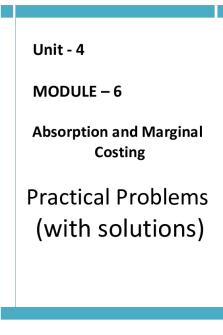Marginal revenue equals marginal cost PDF

| Title | Marginal revenue equals marginal cost |
|---|---|
| Author | Ashley Lash Rader |
| Course | Principles Of Microeconomics |
| Institution | Kent State University |
| Pages | 2 |
| File Size | 83.8 KB |
| File Type | |
| Total Downloads | 70 |
| Total Views | 141 |
Summary
assignment answers...
Description
3/1/2020
Print Preview
Chapter 8: Perfect Competition: 8-2b Marginal Revenue Equals Marginal Cost Book Title: Micro ECON Printed By: Ashley Rader ([email protected]) © 2019 Cengage, Cengage Learning, Inc.
8-2b Marginal Revenue Equals Marginal Cost Another way to find the profit-maximizing rate of output is to focus on marginal revenue and marginal cost. Marginal revenue, or MR (The firm’s change in total revenue from selling an additional unit; a perfectly competitive firm’s marginal revenue is also the market price) , is the change in total revenue from selling another unit of output. In perfect competition, each firm is a price taker, so selling one more unit increases total revenue by the market price. Thus, in perfect competition, marginal revenue is the market price—in this example, $5. Column (2) of Exhibit 8.2 presents the farm’s marginal revenue from each bushel of wheat. In Chapter 7, you learned that marginal cost is the change in total cost from producing another unit of output. Column (5) of Exhibit 8.2 shows the farm’s marginal cost for each bushel of wheat. Marginal cost first declines, reflecting increasing marginal returns in the short run as more of the variable resource is employed. Marginal cost then increases, reflecting diminishing marginal returns from adding more of the variable resource. The firm increases production as long as each additional unit of output adds more to total revenue than to total cost —that is, as long as marginal revenue exceeds marginal cost. Comparing
“A profit-maximizing firm produces where marginal revenue equals marginal cost.”
columns (2) and (5) in Exhibit 8.2, we see that marginal revenue exceeds marginal cost for each of the first 12 bushels of wheat. The marginal cost of bushel 13, however, is $6.50, compared with its marginal revenue of $5. Therefore, producing bushel 13 would reduce economic profit by $1.50. The farmer, as a profit maximizer, limits output to 12 bushels per day. More generally, a firm expands output as long as marginal revenue exceeds marginal cost and stops expanding before marginal cost exceeds marginal revenue. A shorthand expression for this approach is the golden rule of profit maximization (To maximize profit or minimize loss, a firm produces the quantity at which marginal revenue equals marginal cost; this rule holds for all market structures) , which says that a profit-maximizing firm produces where marginal revenue equals marginal cost. Chapter 8: Perfect Competition: 8-2b Marginal Revenue Equals Marginal Cost Book Title: Micro ECON Printed By: Ashley Rader ([email protected]) © 2019 Cengage, Cengage Learning, Inc. © 2020 Cengage Learning Inc. All rights reserved. No part of this work may by reproduced or used in any form or by any means graphic, electronic, or mechanical, or in any other manner - without the written permission of the copyright holder.
https://ng.cengage.com/static/nb/ui/evo/index.html?deploymentId=583265219313318568251256031&eISBN=9781337914413&id=678781607&nbId=1… 1/2
3/1/2020
Print Preview
https://ng.cengage.com/static/nb/ui/evo/index.html?deploymentId=583265219313318568251256031&eISBN=9781337914413&id=678781607&nbId=1… 2/2...
Similar Free PDFs

Demanda marginal
- 50 Pages

Marginal notes
- 1 Pages

Biaya marginal
- 40 Pages

Marginal Principle - Notes.
- 2 Pages

Unidad 4 Analisis marginal
- 23 Pages

Ingreso marginal - lectura
- 8 Pages

Arteria Marginal DEL Colon
- 1 Pages

Lecture 8 - Marginal Costing
- 11 Pages

Distribusi Gabungan dan Marginal
- 4 Pages

2. Marginal Analysis 2021
- 14 Pages
Popular Institutions
- Tinajero National High School - Annex
- Politeknik Caltex Riau
- Yokohama City University
- SGT University
- University of Al-Qadisiyah
- Divine Word College of Vigan
- Techniek College Rotterdam
- Universidade de Santiago
- Universiti Teknologi MARA Cawangan Johor Kampus Pasir Gudang
- Poltekkes Kemenkes Yogyakarta
- Baguio City National High School
- Colegio san marcos
- preparatoria uno
- Centro de Bachillerato Tecnológico Industrial y de Servicios No. 107
- Dalian Maritime University
- Quang Trung Secondary School
- Colegio Tecnológico en Informática
- Corporación Regional de Educación Superior
- Grupo CEDVA
- Dar Al Uloom University
- Centro de Estudios Preuniversitarios de la Universidad Nacional de Ingeniería
- 上智大学
- Aakash International School, Nuna Majara
- San Felipe Neri Catholic School
- Kang Chiao International School - New Taipei City
- Misamis Occidental National High School
- Institución Educativa Escuela Normal Juan Ladrilleros
- Kolehiyo ng Pantukan
- Batanes State College
- Instituto Continental
- Sekolah Menengah Kejuruan Kesehatan Kaltara (Tarakan)
- Colegio de La Inmaculada Concepcion - Cebu





